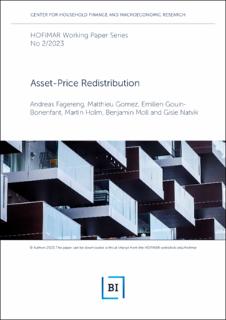| dc.contributor.author | Fagereng, Andreas | |
| dc.contributor.author | Gomez, Matthieu | |
| dc.contributor.author | Gouin-Bonenfant, Emilien | |
| dc.contributor.author | Holm, Martin | |
| dc.contributor.author | Moll, Benjamin | |
| dc.contributor.author | Natvik, Gisle | |
| dc.date.accessioned | 2024-04-04T11:12:12Z | |
| dc.date.available | 2024-04-04T11:12:12Z | |
| dc.date.issued | 2023 | |
| dc.identifier.issn | 2704-1980 | |
| dc.identifier.uri | https://hdl.handle.net/11250/3124840 | |
| dc.description.abstract | Over the last several decades, there has been a large increase in asset valuations across many asset classes. These rising valuations had important effects on the distribution of wealth. However, little is known regarding their effect on the distribution of welfare. To make progress on this question, we derive a sufficient statistic for the (money metric) welfare effect of a change in asset valuations, which depends on the present value of an individual’s net asset sales: rising asset prices benefit prospective sellers and harm prospective buyers. We estimate this quantity using panel microdata covering the universe of financial transactions in Norway from 1994 to 2019. We find that rising asset valuations had large redistributive effects: they redistributed from the young towards the old and from the poor towards the wealthy | en_US |
| dc.language.iso | eng | en_US |
| dc.publisher | BI Norwegian Business School | en_US |
| dc.relation.ispartofseries | HOFIMAR Working Paper Series;2/2023 | |
| dc.title | Asset-Price Redistribution | en_US |
| dc.type | Working paper | en_US |
| dc.source.pagenumber | 87 | en_US |
